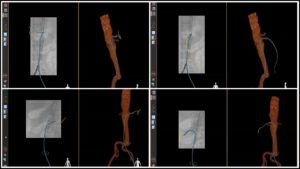
Vascular surgeons at the University of Massachusetts became the first in the United States to carry out procedures using the breakthrough imaging technology Fiber Optic RealShape (FORS) last month, reporting a 75% decrease in fluoroscopy use after one of their earliest experiences of the system—a fenestrated endovascular aneurysm repair (FEVAR) of a thoracoabdominal aortic aneurysm (TAAA).
Andres Schanzer, MD, professor and chief of vascular surgery at the University of Massachusetts Medical School in Worcester, whose team is at the vanguard of the technology’s debut Stateside, describes the platform as representing “a transformative change” in how surgeons navigate vascular anatomy.
FORS, developed by Philips, is currently available at a limited number of centers in Europe and the U.S. as it continues to undergo clinical study. The technology has CE mark approval in Europe and is Food and Drug Administration (FDA) 510(k) cleared.
The platform, which enables real-time 3D visualization of the full shape of devices inside the body without the need for stepping on the fluoroscopy pedal, sends pulses of light through hair-thin optical fibers within minimally invasive devices.
Schanzer illustrates how a busy complex aortic practice at his institution currently depends on X-ray imaging for the entirety of procedures.
“What FORS has enabled us to do is to really get away from using X-ray for all of the steps of the procedure,” he tells Vascular Specialist in an interview shortly after undertaking his third procedure with the platform. “[This is achieved with] fiber optic wires and catheters to decrease our reliance on X-ray.”
In addition to the decreased radiation and lowered procedure time FORS allows, Schanzer continues, another notable advantage includes an ability to work with completely new angles than those to which vascular surgeons are accustomed with X-ray. “There’s no limitation on having to move a C-arm gantry around a patient,” he says. “You can be looking at several different angles like a biplane view at the same time. I think it’s going to change the way we look at all vascular interventions.”
Quantifying the exact radiation reduction is going to take time and data to determine, Schanzer says. But by his third case, the four-vessel type II TAAA FEVAR, his team was able to decrease radiation use compared to their mean for that extent of repair from an average of 88 minutes down to just 22 minutes, or 75%.
“We are at the very start of our learning curve,” Schanzer says, reporting that by the end of May he and colleagues should have completed six cases with FORS. “We’re really trying to see exactly where it fits in and how to maximize its use, and maximize the benefits to patients.”
FORS is expected to be rolled out to a total of five U.S. centers as part of clinical trials, in addition to the same number in Europe.
Shortly before FORS’ debut in the U.S., during the Charing Cross (CX) 2021 Digital Edition Gustavo Oderich, MD, professor and chief of vascular and endovascular Surgery at the University of Texas’ McGovern Medical School in Houston, emphasized its potential, suggesting that “radiation will be a thing of the past” thanks to this new technology.
“I’ve always had a really strong interest in imaging,” Schanzer comments. “I believe the imaging side of what we do is just as important as the device side. This is certainly the biggest leap forward that I have seen in my career with regards to the imaging.”
Ultimately, the technology is at the start of its journey, he adds. “Currently, we’ve only used it in complex aortic procedures but I very much see us broadening the applicability in all types of vascular cases.
“This is a first-generation technology, and I think there is still room for improvement as we expand the devices, the catheters and the wires that are enabled with this technology. I think that’s going to happen very quickly. This proof of concept we’ve already seen in a few cases that have been done around the world really shows the enormous value that this technology holds.”












